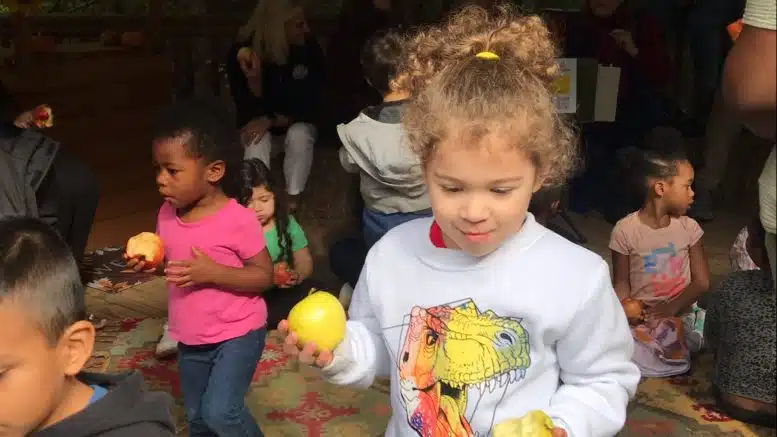By Anne Blythe
Trying to get wholesome food into young children might seem like an exhausting exercise for many parents and child care providers in today’s rush-rush world.
After all, life can get hectic.
Perhaps one child had to be dropped off at dance class and another needed to be rushed home after school to grab forgotten soccer cleats before being ferried back to the game. Unexpected, yet all-too-common, events like that cut into time that might otherwise be used for meal planning or food shopping.
The thought of peeling carrots or chopping vegetables can easily be pushed off to another night after a long day of work and carpooling. Especially when those lovable little ones hovering underfoot in the kitchen morph into hangry fussbudgets with little patience for the time it takes to prepare a well-balanced meal.
Perhaps such pressures have contributed to the findings of a study published by JAMA that looked at consumption trends over nearly two decades. The researchers found that by 2018, 67 percent of the calories in the diets of children and teens, ages 2 to 19, were from ultra-processed foods.
So this NC Farm to School and Early Care and Education Month could be the perfect time to teach children that some of the healthier food doesn’t come out of a box or glitzy package from the convenience store. Tasty treats can be found on a tree branch or dangling from a root vegetable pulled from the soil. They can be nutritious, too, without all the sugars, salt and fats found in ultra-processed foods in snack food aisles or store freezers.
The North Carolina Farm to Preschool Network has been working for eight years to help young children and their families better recognize the importance of healthy eating habits while also connecting them to local farm networks and community gardens. They’ve stepped up their efforts this month with messages that can resonate at home, at school or in the many child care centers that look after younger children.
The network, which aims to integrate nutrition education with diverse local food procurement and on-site gardening, is sponsoring North Carolina Crunch. The statewide event has preschool children, their families and caregivers munching on apples and fall vegetables as part of a campaign to reach at least half a million people in all 100 counties and celebrate North Carolina agriculture.
Connecting farmers and communities
Kimberly Shaw, owner of A Safe Place Child Enrichment Center in Raleigh, is one of the participants and a member of the network advisory committee.
The network has developed tools for child care providers who might need help deciding how many tomatoes, blueberries or pounds of fresh fruits and vegetables to purchase for children in daycare and after-school programs. They’ve broken the information down by age groups for 1- to 2-year-olds, 3- to 5-year-olds, and 6- to 18-year-olds.
“We think this is important work because our children are important, and the health of those children are in the adults’ hands,” Shaw said at an event last week in which the children in her care gathered under a gazebo and sang songs celebrating the crunch of an apple. “We think if you shape a child’s palate at a young age, you can change those health outcomes to be the best that they can be.”
The child care center, housed in the middle of a residential neighborhood in the state’s capital city, abuts a backyard garden plot where new kale leaves riseout of freshly tilled soil and Rhode Island Red chickens peck at the ground, hunting for grubs and other insects.
Abram Shaw, or Mr. Abram, as the kids call him, is the garden director and head of community outreach.
“Garden and community kind of go hand-in-hand,” Abram Shaw said. “In so many words, this is about reconnecting our community, our children with fresh and local produce, and letting them know that I’m a farmer and you don’t need a tractor, you don’t need acres of land to grow food and eat local, eat fresh. You can do it. You can start small with a vision, and this is where we are today.”
Backyard gardens won’t be possible for all child care centers. The network offers a decision-making tree in English and Spanish to help providers figure out whether a farmer’s market stand, food hub, grocery store, local farm or weekly box delivered from one would work best for the size and mission of the organization.
It’s difficult not to get excited about NC Farm to School and Early Care and Education Month, when preschool children are belting out an “Apple Crunch” song before sinking their teeth into the treats awaiting them in a red wagon pulled into the gazebo.
Across the lifespan
Susan Osborne, deputy secretary of opportunity and well-being at the state Department of Health and Human Services, joined in the festivities this week at A Safe Place Child Enrichment Center, as did Diane Beth, nutrition program consultant with the DHHS Division of Child and Family Well-Being Whole Child Health Section.
“We know that good nutrition is important across the lifespan, but especially it’s important for our growing children, growing bones, bodies, blood, all those things that they need to fuel every day,” Beth said. “Of course we know that farm to early care in education is especially important because it’s really about teaching kids where their food is coming from — from their farmers, whether they’re growing it in their own gardens themselves.”
There has been an attempt across the country to introduce more fruits and vegetables into the diets of children with fewer ultra-processed chips, cookies and pre-packaged meals. Newer research is showing that ultra-processed foods have contributed to increased rates of obesity, diabetes and even high blood pressure in children, as well as adults.
More than a third of North Carolina’s children are obese or overweight, according to national statistics. Too often, they grow into adults with diseases such as diabetes and high blood pressure. An estimated one in ten North Carolina adults have diabetes. More than a third have been diagnosed with high blood pressure.
The Centers for Disease Control and Prevention reports that one in two North Carolina children ages 1 to 5 do not eat a daily vegetable, according to DHHS. One in three preschool children do not eat a daily fruit. The farm to preschool program has helped increase the consumption of fruits and vegetables by one daily serving, according to program findings.
The CDC touts the Farm to Early Care and Education programs as ones that can teach children “about healthy food by engaging all five senses” through activities such as gardening, farm visits and taste-testing local produce. Those activities can improve a child’s diet and well-being, according to the CDC.
“It’s really important to have really fun taste tests to get to taste new foods,” Beth added. “Programs like this … are helping to support meals and nutritious meals. That can be really important.”
Learning to farm with the children
Participants celebrating the Farm to School and Early Care and Education Month are encouraged to share videos and photos online.
In Raeford, Robin Wright-Galbreath at Robin’s Nest Family Child Care is lauded for her green thumb.
“I never knew really a whole lot about farming or what it took to do it, but being introduced to the program has showed me that there are things I can do on a smaller scale to help the families and introduce other families to it, as well, and learn right along with me,” Wright-Galbreath said in a video posted to the NC Farm to Preschool Network YouTube Channel. “The children love the outdoors. They love the outdoors. We all learn in different ways. Sometimes what you may try to teach them on the inside may not go over as well, but if you try to teach them on the outside and try to do the same thing, you have a lot better results from it because they love the outdoors.”
Rhonda Ray of Abundantly Love Child Care, who says she doesn’t have the gift of growing that Wright-Galbreath has, thinks it’s important for the children she cares for to learn lessons from the land. They send seeds home with the little ones, and treat them to seasonal fruits such as watermelon, peaches and strawberries in the summer.
Some attempts to expand the young ones’ tastes don’t always win rave reviews. Kale chips, for example, got a two-thumbs-down critique.
“I think it’s very important that the kids know where the local food is coming from and then that lets them know, hey, we don’t have to always buy everything out of the store,” Ray said in the video with Wright-Galbreath.“We can go to a local farmer and get the product. And that’s a good thing. That’ll teach the kids, ‘Look, it’s working to do this. It ain’t just peeling it. Just because it’s in the store, someone had to grow it, and let them know, hey, this was how it was grown.’”













